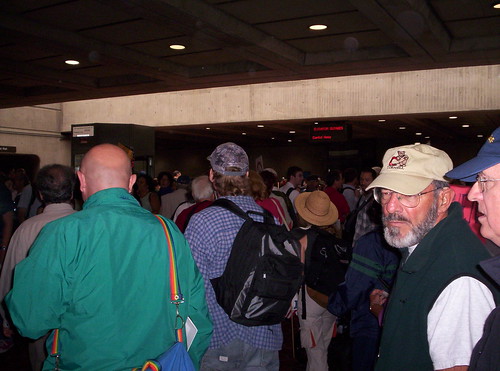Should transit on inauguration day be free (Reprint)
I wish I could score one of these special MetroCards. This is likely one of the only times Trump's picture will feature in this blog.
Trying not to think about the coming presidency of Donald Trump, but this Washington Post article, "D.C. prepares for more than 200,000 inauguration visitors — and protesters," and others ("WMATA Inauguration service information," WMATA) reminded me. And that it's worth revisiting this past blog entry, "Should transit on Inauguration Day be free? (Reprint),"
Note that this year, 2025: some stations will be closed within the National Mall area, and service will start at 4 am but "Everyone over the age of 5 needs a SmarTrip card to enter and exit stations"--which as I discuss below creates a throughput problem of great proportion.
On the other hand, if there will be a maximum of 250,000 attendees, it won't be much of a problem to accommodate them.
========
The original post was from January 2, 2013, about 3 weeks before the Inauguration for President Obama's second term.
The first Inauguration in 2009 was probably the absolute peak of success for WMATA, with more than one million subway riders that day--and it was about 6 months before the terrible crash at Fort Totten which killed nine people.
The latter, along with the opening of the Silver Line, seem to be the key events in marking the decline of the WMATA system in terms of service, operations, and ridership declines.
While WMATA probably can't successfully carry that many people today, it was a high point in the system's history and the points made below still pertain.
In short, I argue that for transportation demand and system management goals, transit in the DC area should be free on Inauguration Day.
Note that I considered listing this in the previous entry, but I don't think this should be paid for by the local jurisdictions and the transit agencies. Instead the cost should be covered by the Presidential Inauguration Committee.
The entry is edited slightly from the original.
======
Many transit authorities--San Francisco, Minneapolis, Madison, Reno, Long Beach, Edmonton, Milwaukee (paid for by Miller Beer, which was based in that city for decades), Calgary to mention a few--provide free transit during the night and into the wee hours of New Year's Eve, the idea being that it's better that people ride transit than drive drunk.
(This is separate from "Sober Ride" initiatives, such as in the DC region, where on New Year's Eve, inebriated patrons can get free taxi rides--up to $30.)
Seeing this piece in the Post, "Tour bus operators fret that passengers may have a hike to presidential inauguration," about procedures for charter bus management during the Inauguration, thinking about witnessing charter bus drop off for other "special events" at outlying stations such as in Greenbelt, and thinking about yesterday, makes me wonder if as part of special event management:
Perhaps transit service on the WMATA system should be free the day of the Inauguration Parade?, in this case Monday January 21st, 2013.
This would speed throughput, increase safety (in 2009 crowds exceeded the capacity of some stations and to move people through station managers just opened the gates and let people in for free--see "Mall east of 14th St. reaches capacity," this piece lists hour by hour rider counts for the subway up to 11am, from WTOP, the after action report from MWCOG, and comments in this Post article "Metro Ridership Tops 1 Million, Shattering Record"), and minimize confusion. (Also see "Metro approves expanded Inauguration Day service, fees" from the Post.)
The system isn't really designed to move through hundreds of thousands of people in a relatively short time window--mechanical chokepoints at fare machines and fare gates slow operations significantly--especially when a bulk of the riders are unfamiliar with using transit.
So don't charge individuals (and charge the Inauguration Committee to cover the lost revenue) in order to reduce the crush on the system by not having to use those trip-slowing mechanical components.
Making transit free on Inauguration Day will speed throughput, which is a desirable benefit in terms of facilitating mobility and reducing "friction."
Transit Throughput Delays
1. Buying farecards. In 2009 we left town to be away from Inauguration madness--although the madness didn't really makes it way up to where we live--and at the Priory Inn in Pittsburgh, we were talking to some people on their way to DC for the Inauguration.
I said the biggest thing they should do is have the guy's daughter (who lived somewhere in Northern Virginia) buy them loaded transit passes, because the biggest delay in getting on is dealing with people buying transit tickets, and being flummoxed trying to figure out how to use the fare machine(s).
I don't know what the throughput is per hour for the fare machines, but it can't be much better than 1.5 people/minute.
That's with (uncrumpled) cash. It's even slower when using credit cards.
I joke that the blue machines--where you are supposed to indicate how much money you want on a card--which are more difficult to use, draw the inexperienced like moths to light. And they are the only machines that take credit cards. Left: Greenbelt Station on the day of a protest, full of people being dropped off by tour buses, and being shepherded to Downtown DC via the Metro (2005).
Left: Greenbelt Station on the day of a protest, full of people being dropped off by tour buses, and being shepherded to Downtown DC via the Metro (2005).
2. Getting through faregates. The gates open and close for each patron. The throughput per gate is just a few people per minute.
3. Congested station entryways (foyers). Station foyers in many stations are small, and the combination of lines at the farecard machines and lines at the fare gates can overcrowd the stations very quickly.
4. Paying when entering a bus. Similarly, delays on buses mount with long lines, and each person having to pay upon entry, either with cash or with a Smart Card. Paying transit fares in cash on the bus will significantly slow movement of the bus--and it costs at least 6 cents/second to operate a bus.
Mobility planning for special events in the National Capital (demonstrations and other events on the National Mall)
Note that special event mobility planning for events held on the National Mall is in need of a reboot. See "A broken record on transportation demand management planning, this time with regard to special events." But in that blog entry, from 2010, I didn't suggest free transit as a way to cope.
See "A broken record on transportation demand management planning, this time with regard to special events." But in that blog entry, from 2010, I didn't suggest free transit as a way to cope.
Right: crowd waiting for buses (because of a subway system breakdown).
SF MUNI: Free transit on agency's 100th anniversary. Note that I am probably being influenced by how SF MUNI didn't charge for transit on their 100th anniversary. See "Free Muni for…everyone…for a day" from the San Francisco Chronicle.
Free transit on bad air days. Also, places with strict Air Quality Management requirements often provide free transit on days when air quality is particularly poor, as a way to discourage driving (although I doubt that providing free transit on those days shifts that many people from driving). More recently, Paris has been forced to do this in an attempt to address air quality ("Paris makes all public transport free in battle against 'worst air pollution for 10 years': Temporary measures also include allowing only cars with odd-numbered licence plates to use roads," Independent; "Madrid's Bold New Pollution Plan: Ban Cars and Make Transit Free," CityLab).
There are some special event transportation planning resources out there, but even they may be insufficiently creative.
-- Special Event Transportation Service Planning and Operations Strategies for Transit
-- for the road network, National Cooperative Highway Research Program (NCHRP) Synthesis 309: Transportation Planning and Management for Special Events
-- Managing Travel for Planned Special Events (FHWA training course)
-- National Special Security Events: Transportation Planning for Planned Special Events Left: JANUARY 20, 2009: Spectators sit in trash and debris along the National Mall after the inauguration of Barack Obama as the 44th president of the United States of America January 20, 2009 in Washington, DC. Obama became the first African-American to be sworn in as president in the history of the United States. (Photo by Robert Nickelsberg/Getty Images)
Left: JANUARY 20, 2009: Spectators sit in trash and debris along the National Mall after the inauguration of Barack Obama as the 44th president of the United States of America January 20, 2009 in Washington, DC. Obama became the first African-American to be sworn in as president in the history of the United States. (Photo by Robert Nickelsberg/Getty Images)
The latter report specifically discusses Presidential Inaugurations, and with the Inauguration of President Obama in 2009, for the first time the Federal Government made some funds available to local jurisdictions for costs, including transit-related, incurred as a result of supporting the event. From the report:
For example, Congress allocated funding to state and local agencies in Virginia following the 56th Presidential Inauguration of Barack Obama, for security (police, fire), transportation (transit buses), and other services (environmental services, parks and cultural resources, and human services). In the event that Congress appropriates funds to reimburse agencies for their NSSE costs, detailed documentation of that cost data will be necessary. The January 20, 2009, inauguration of President Barack Obama used NSSE funding of $15 million for “emergency planning and security costs.”
Additionally, for the same inauguration, then President George W. Bush declared a state of emergency for the District of Columbia, which authorized the federal government to reimburse the District for emergency preparedness activities and expenditures that exceeded $15 million.
BUT, the report does not suggest providing free transit as a way to reduce congestion, speed transit throughput, and manage crowds.
MWCOG after action report
Although the report did mention that some stations closed the entryways due to platform overcrowding, the report didn't significantly review WMATA experiences as reported in the media and comments on articles in social media. The report doesn't state that at some stations operators opened the faregates to reduce overcrowding as the lines bunched up, and it didn't identify systematically various chokepoints and bottlenecks within transit system processes including those listed above.
And while the report didn't comment on general throughput issues with regard to WMATA inside stations and buses, it does suggest not charging for parking at transit stations, as a way to increase station throughput and to reduce traffic congestion waiting to get through the entry gates. (On special event days, it would be useful to have signage providing real-time data on parking space availability.)
Conclusion
1. Don't charge for transit on the day of the Presidential Inauguration, let there be free transit for the day.
2. Still charge for parking at transit stations, as free parking would just fill up fast anyway and more quickly (witness what happened at stations near the Redskins Stadium before WMATA started charging for weekend parking at those stations). But plan to manage the road congestion and somehow provide some real-time information about parking availability at those stations.
3. And for that day only, have the capacity to accept cash for parking at transit stations.
(Ideally, WMATA could have real-time parking availability information systems, but the reality is that except for a couple times each year, there isn't financial justification for providing this kind of system.)
4. While this entry focuses on WMATA, free transit service should also be provided on that day by DC Circulator, RideOn, DASH, ART, The Bus (PG County), and Fairfax Connector. Again, it should be paid for by the Presidential Inauguration Committee and/or the Federal Government.
Labels: parking and curbside management, special event transportation, special events and programming, transit marketing, transportation demand management, transportation planning





1 Comments:
https://www.ebay.com/itm/126896011045
Post a Comment
<< Home